Decaffeinated Coffee: Methods, Risks, and Health Concerns
Decaffeinated coffee offers a caffeine-free alternative for those looking to reduce their intake while still enjoying the rich, complex flavors of their favorite brew. However, the process of removing caffeine is not as straightforward as it might seem. Various methods are used to decaffeinate coffee, each with its own set of potential health risks, particularly concerning the solvents used. This article delves into the three primary methods for decaffeinating coffee—solvent-based, water-based, and carbon dioxide processes—and explores the associated health concerns, especially focusing on chemical solvents and their potential dangers to the liver and kidneys.
Click here to get Shilajit. Use the discount code: HealthyWildFree for 10% off!
Click here to visit Radiate21.com.
Click here to get the cleanest and healthiest Organic coffee I have found. 30% off your first order!
1. The Solvent-Based Method
The solvent-based method is one of the oldest and most commonly used techniques for decaffeinating coffee. This process involves soaking coffee beans in a solvent that selectively removes caffeine. The two main solvents used in this method are methylene chloride and ethyl acetate.
a. Methylene Chloride
Methylene chloride, also known as dichloromethane, is a volatile organic compound often used in the decaffeination process due to its efficiency in dissolving caffeine. Here’s how it works:
- Steaming: The coffee beans are first steamed to open their pores.
- Soaking: Beans are then soaked in methylene chloride, which selectively binds with caffeine.
- Rinsing: The caffeine-laden solvent is drained away, and the beans are steamed again to remove any residual solvent.
While methylene chloride is effective, it has been linked to several health concerns. Chronic exposure to this chemical has been associated with liver and kidney damage, respiratory issues, and even cancer. The U.S. Environmental Protection Agency (EPA) classifies methylene chloride as a probable human carcinogen. Although the amounts of methylene chloride left in decaffeinated coffee are minimal, the potential health risks remain a concern for some consumers.
b. Ethyl Acetate
Ethyl acetate, a naturally occurring compound found in fruits, is another solvent used in the decaffeination process. The method is similar to that of methylene chloride:
- Steaming: Beans are steamed to open their pores.
- Soaking: Beans are soaked in ethyl acetate, which bonds with caffeine.
- Rinsing: The solvent is drained, and beans are steamed again to eliminate residues.
Ethyl acetate is often marketed as a “natural” solvent because it can be derived from fruits. However, this does not necessarily mean it is entirely safe. Ethyl acetate is less toxic than methylene chloride but still poses potential health risks. Prolonged exposure to high concentrations of ethyl acetate can lead to respiratory issues, skin irritation, and potential liver and kidney damage. Like methylene chloride, the trace amounts remaining in decaffeinated coffee are generally considered safe by regulatory agencies, but the risks associated with chemical exposure should not be ignored.
2. The Water-Based Method
The water-based method, also known as the Swiss Water Process, is a solvent-free alternative to the traditional chemical-based methods. This technique uses water to extract caffeine from coffee beans.
- Steaming: Coffee beans are steamed to open their pores.
- Soaking: Beans are soaked in hot water, which dissolves caffeine and other soluble compounds.
- Filtering: The water, now containing caffeine and other solubles, is passed through an activated carbon filter that traps caffeine molecules.
- Re-soaking: The decaffeinated beans are re-soaked in the filtered water to reabsorb flavors and oils.
The Swiss Water Process is considered one of the safest methods for decaffeinating coffee, as it avoids the use of chemical solvents. The water-based method is also praised for preserving more of the beans’ original flavor compared to solvent-based methods. However, it is worth noting that the Swiss Water Process is more expensive and less widely used due to the complexity and cost involved.
3. The Carbon Dioxide Method
The carbon dioxide (CO2) method is a more recent and sophisticated approach to decaffeination. This process utilizes high-pressure CO2 to selectively extract caffeine from coffee beans.
- Steaming: Beans are steamed to open their pores.
- Pressurizing: Beans are placed in a chamber where they are exposed to liquid CO2 under high pressure.
- Extraction: The CO2 acts as a solvent, bonding with caffeine and separating it from the beans.
- Separation: The caffeine-rich CO2 is then transferred to another chamber where the pressure is reduced, causing the CO2 to return to its gaseous state and leaving the caffeine behind.
The CO2 method is known for its efficiency and ability to preserve the coffee’s flavor profile. It is also considered to be one of the safest methods, as CO2 is a naturally occurring, non-toxic gas. The CO2 used in the process is typically recycled, reducing environmental impact and exposure risks. Despite its advantages, the CO2 method is more costly and complex than other methods, which limits its use to premium coffee brands and specialty roasters.
Health Risks and Chemical Solvents
While the CO2 method minimizes health risks due to its solvent-free nature, the solvent-based methods—particularly those involving methylene chloride and ethyl acetate—raise valid health concerns. Methylene chloride, a petroleum-derived solvent, is a significant concern due to its toxic effects on the liver and kidneys. Chronic exposure to this chemical, even in trace amounts, has been associated with serious health issues, including:
- Liver Damage: Methylene chloride can cause liver damage by inducing toxic metabolic byproducts.
- Kidney Damage: The chemical can impair kidney function, leading to potential long-term health complications.
- Cancer Risks: The EPA’s classification of methylene chloride as a probable carcinogen highlights its potential to cause cancer, especially with long-term exposure.
Ethyl acetate, though less harmful than methylene chloride, still presents potential risks. Prolonged exposure can lead to:
- Respiratory Issues: Inhalation of ethyl acetate vapors can irritate the respiratory system.
- Skin Irritation: Direct contact with ethyl acetate can cause skin irritation and sensitization.
- Liver and Kidney Effects: High exposure levels may impact liver and kidney function, although these effects are less pronounced compared to methylene chloride.
Conclusion
Decaffeinated coffee provides a caffeine-free option for coffee lovers, but the methods used to remove caffeine can have varying health implications. The solvent-based methods, while effective, pose risks due to the chemicals involved, particularly methylene chloride and ethyl acetate. These risks include potential liver and kidney damage, as well as other health concerns.
The water-based and carbon dioxide methods offer safer alternatives, with the Swiss Water Process avoiding chemicals altogether and the CO2 method using a non-toxic gas. However, these methods come with higher costs and limited availability.
When choosing decaffeinated coffee, consumers should consider not only their preference for flavor but also their concerns about potential chemical exposure. Opting for coffee decaffeinated using safer methods or brands that prioritize health-conscious practices can help mitigate the risks associated with caffeine removal processes. As always, staying informed and making choices that align with personal health priorities is crucial for enjoying coffee responsibly.
What You Should Know About Coffee:
Using MCT Oil, Coconut Cream, and Bone Broth to Slow Caffeine Absorption and Alkalize pH
Incorporating MCT oil, coconut cream, and bone broth into your diet can offer unique benefits for managing caffeine absorption and maintaining a more alkaline pH balance in the body. Each of these components plays a role in moderating the effects of caffeine and supporting overall wellness.
MCT Oil: Medium-Chain Triglyceride (MCT) oil is derived from coconut oil and is known for its rapid absorption and metabolism in the body. MCT oil can help slow the absorption of caffeine by providing a steady release of energy. When consumed alongside caffeinated beverages, MCT oil forms a lipid barrier that can delay the gastric emptying process. This means caffeine is gradually released into the bloodstream, reducing the intensity of its stimulant effects and prolonging its energizing impact. Additionally, MCT oil can help stabilize blood sugar levels, further mitigating the jittery or anxious feelings often associated with caffeine consumption.
Coconut Cream: Coconut cream, rich in healthy fats, can also play a significant role in managing caffeine absorption. Like MCT oil, coconut cream can slow the rate at which caffeine enters the bloodstream. The fat content in coconut cream forms a layer in the digestive system, which can delay the absorption of caffeine and help maintain a more consistent energy level. Moreover, coconut cream has an alkaline-forming effect on the body. Despite its slightly acidic taste, coconut cream metabolizes into alkaline compounds, contributing to a more balanced pH level in the body. This alkalizing effect helps counteract the acidic nature of caffeine and supports overall pH balance.
Bone Broth: Bone broth is not only a nutritious addition to your diet but also has benefits for pH balance and digestion. Rich in minerals like calcium, magnesium, and potassium, bone broth helps buffer the acidity in the body and promotes a more alkaline environment. Consuming bone broth alongside or after caffeinated beverages can help neutralize excess acidity and support optimal digestion. Additionally, the amino acids and gelatin found in bone broth can help soothe and repair the gastrointestinal tract, which can be beneficial for individuals sensitive to caffeine’s effects on the stomach.
I get both plain and vanilla bone broth (which is delicious) from Paleovalley.com. Click here to get 15% off your order. They also have a really great certified organic coffee, so grab a bag and try it while you’re there!
Combining these three components—MCT oil, coconut cream, and bone broth—into your routine can create a synergistic effect that helps manage caffeine absorption and supports a more alkaline pH balance. Adding a spoonful of MCT oil to your morning coffee, mixing coconut cream into your smoothie, or sipping on bone broth can be effective strategies to mitigate caffeine’s impact and promote overall well-being. By incorporating these elements thoughtfully, you can enjoy the benefits of caffeine while minimizing its potential drawbacks.
I highly recommend Purity Coffee (caffeinated or decaffeinated) if you do drink coffee. This company is not only organic but biodynamically grown, it is the healthiest, cleanest coffee I have found. It is lowest in heavy metals, mold free and highest in antioxidants.
Get 30% off your first Purity coffee order by clicking here.





